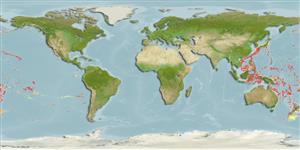Common names from other countries
Environment: milieu / climate zone / depth range / distribution range
Ecologia
marinhas batidemersal; intervalo de profundidade 253 - 580 m (Ref. 28982). Deep-water
Pacific Ocean: New Caledonia, southern Japan, and the Hawaiian Islands (Ref. 9824); including the Norfolk Ridge and Isle of Matthew (Ref. 28982).
Tamanho / Peso / Idade
Maturity: Lm ? range ? - ? cm
Max length : 22.5 cm SL macho/indeterminado; (Ref. 9824)
Espinhos dorsais (total) : 0; Raios dorsais (total) : 106 - 117; Espinhos anais: 0; Raios anais : 87 - 95; Vértebras: 32 - 33. Body elliptical, its depth contained more than 2.4 times in SL. Tip of isthmus below posterior margin of lower eye. Eyes separated by a broad and concave space. Interorbital in male broader than that in female. Ctenoid scales on ocular side armed with a row of hairlike spines. Small dark blotches on origin of straight part of lateral line. Small dark dots along upper margin of upper eye.
Inhabits mud and sand bottoms (Ref. 9824). Benthic (Ref. 58302). Feeds on small benthic animals. Marketed fresh, sometimes dried-salted (Ref. 9824).
Ciclo de vida ou comportamento de acasalamento
Maturities | Reprodução | Spawnings | Egg(s) | Fecundities | Larvas
Hensley, D.A. and K. Amaoka, 2001. Bothidae. Lefteye flounders. p. 3799-3841. In K.E. Carpenter and V. Niem (eds.) FAO species identification guide for fishery purposes. The living marine resources of the Western Central Pacific. Vol. 6. Bony fishes part 4 (Labridae to Latimeriidae), estuarine crocodiles. FAO, Rome. (Ref. 9824)
Status na Lista Vermelha da UICN (Ref. 130435)
CITES (Ref. 128078)
Not Evaluated
Ameaça para os humanos
Harmless
Uso pelos humanos
Pescarias: espécies comerciais
Ferramentas
Relatórios especiais
Baixar XML
Fontes da internet
Estimates based on models
Preferred temperature (Ref.
115969): 6.8 - 13.9, mean 10.7 (based on 113 cells).
Índice de diversidade filogenética (Ref.
82804): PD
50 = 0.5020 [Uniqueness, from 0.5 = low to 2.0 = high].
Bayesian length-weight: a=0.00912 (0.00408 - 0.02036), b=3.05 (2.87 - 3.23), in cm Total Length, based on LWR estimates for this (Sub)family-body shape (Ref.
93245).
Nível Trófico (Ref.
69278): 3.5 ±0.37 se; based on food items.
Resiliência (Ref.
120179): Baixo, tempo mínimo de duplicação da população 4,5 - 14 anos (Preliminary K or Fecundity.).
Fishing Vulnerability (Ref.
59153): Low vulnerability (17 of 100).
